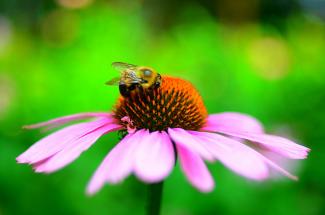
Image Credit: Will Marlow
This material was written Br Dr. Andrew Moldenke, Oregon State University ecologist, with funds provided by a grant from the Gray Family Foundation.
Why study pollination?
It is fun and exciting. If you appreciate the little things that make life interesting (i.e., the shape of a flower, the weird behavior of a bug, the infinite observations that can be shared between explorers, observing actions that no one has ever seen before), then you can’t beat watching the interactions between plants and bugs.
It is important. When it comes to fundamental Earth-level scientific processes, there are only a few really BIG ones! Biogeochemical cycles, which determine the abiotic state of the Earth over immense periods of time, and DNA, which through reproduction by meiosis drives the biotic composition upon the Earth surface. These two interacts with each other, of course.
Through the past 2 billion years, the process of evolution has worked through the process of meiosis (and simpler processes that pre-date meiosis) to produce the life forms we know of.
Pollination is the process which is now regulating the changing DNA in nearly all the terrestrial forms of life here in the PNW. Importance doesn’t get much bigger than that!
There are 2 basic themes underlying pollination relationships in PNW open-canopy plant communities:
1) Flower-visiting arthropod diversity is naturally hyperdiverse, except in the moist foggy communities along the immediate coast;
2) this diversity includes an enormous set of functional guilds of arthropods, including a large percentage of species which immigrate from neighboring community types in order to facilitate mating by pairing up on flowers.
Most ecologists regard bees to be the best pollinators, however, my own studies in many communities in North and South America consistently show that bees comprise only a minority of the flower-visitors in most communities. All of these other groups of flower-visiting arthropods should not be disregarded out-of-hand, because they may provide critical pollination for many species in nearly every community.
Here follows an introductory list of the flower-visiting arthropod functional guilds documented in our studies at the Andrews Experimental Forest, Blue River, Oregon. The purpose of this list is to demonstrate the enormous diversity of flower-visitors, and the fact that nearly all guilds of flying insects that live in open-canopy communities, as well as many that inhabit forested communities and have to migrate, are intimately involved in the complex process of plant pollination.
Visit the Research and Backyard Ecology pages to find printable guides and details on how you can monitor pollinators in your own yard.

/index.jpg)
